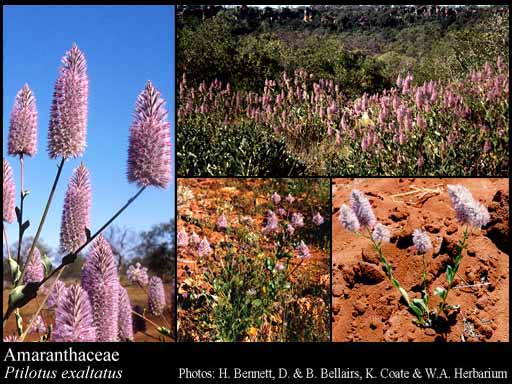- Reference
- Gen.Pl. 87-88 (1789)
- Name Status
- Current







Scientific Description
Common name. Amaranth Family.
Habit and leaf form. Shrubs (usually), or herbs. Plants succulent (occasionally, if Hemichroa is placed here rather than in Chenopodiaceae). Plants with neither basal nor terminal concentrations of leaves (usually), or with a basal concentration of leaves (rarely, e.g. some Ptilotus species). Self supporting, or climbing (occasionally). Leaves alternate, or opposite; ‘herbaceous’ (mostly), or fleshy (only Hemichroa?); sheathing, or non-sheathing; simple. Leaf blades entire; pinnately veined. Leaves without stipules. Leaf blade margins entire. Domatia commonly recorded. Stem anatomy. Nodes unilacunar. Secondary thickening developing from a conventional cambial ring, or anomalous; when anomalous, via concentric cambia.
Reproductive type, pollination. Fertile flowers hermaphrodite, or functionally male and functionally female, or hermaphrodite and functionally male, or hermaphrodite and functionally female, or functionally male, or functionally female. Unisexual flowers present, or absent. Plants hermaphrodite (usually), or monoecious, or andromonoecious, or gynomonoecious, or dioecious, or androdioecious, or polygamomonoecious (rarely).
Inflorescence and flower features. Flowers solitary, or aggregated in ‘inflorescences’; in cymes. The terminal inflorescence unit when flowers aggregated, cymose. Inflorescences racemes of cymes; with involucral bracts, or without involucral bracts; pseudanthial, or not pseudanthial. Flowers bracteate (usually conspicuously). Bracts persistent. Flowers bracteolate (usually conspicuously). Bracteoles persistent. Flowers regular (usually), or somewhat irregular (e.g. Ptilotus, where the inner calyx members are often smaller and the androecial members very unequal); cyclic; tricyclic. Free hypanthium absent (except, dubiously, in some Ptilotus species). Hypogynous disk absent. Perianth sepaline (dry and scarious); 3–5; sepaloid, or petaloid; non-fleshy; persistent; accrescent, or non-accrescent. Calyx present; 3–5; polysepalous, or gamosepalous (partially); imbricate; regular; persistent (dry, stiff, scarious); accrescent, or non-accrescent. The fruiting calyx not berrylike. Calyx when K 5, with the median member posterior. Corolla absent. Fertile stamens present, or absent (rarely, when flowers female). Androecium (1–)2, or 5, or 6–10. Androecial sequence not determinable. Androecial members free of the perianth, or adnate (to the perianth or disk); more or less markedly unequal (usually), or all equal (some Ptilotus species); usually at least basally coherent; 1 - adelphous (the filaments usually connate for all or part of their length into a membranous tube); 1 -whorled. Androecium exclusively of fertile stamens, or including staminodes (some stamens may lack anthers, and in addition, there may be ‘petaloid enations’ ‘pseeudostaminodial structures’ alternating with the anthers). Staminodes when present, 1–3, or 2, or 3, or 5; when present, petaloid, or non-petaloid. Stamens (1–)3–5; oppositisepalous. Anthers dehiscing via longitudinal slits; introrse; unilocular to bilocular; bisporangiate, or tetrasporangiate. Pollen shed as single grains. Fertile gynoecium present, or absent (rarely, when flowers male). Gynoecium 2–3 carpelled. The pistil 1 celled. Gynoecium syncarpous; synovarious to synstylovarious, or eu-syncarpous; superior. Ovary unilocular; 1 locular. Gynoecium stylate, or non-stylate to stylate. Styles 1–3. Stigmas 1–3; dry type; papillate; Group II type. Placentation basal. Ovules in the single cavity 1, or 2–5; ascending (usually), or pendulous (from a basal funicle, subtribe Achyranthinae, Ptilotus, Pupalia, etc.); non-arillate; campylotropous.
Fruit and seed features. Fruit fleshy, or non-fleshy; dehiscent, or indehiscent; a capsule, or capsular-indehiscent, or a berry, or a drupe, or a nut (often a utricle or nutlet); without fleshy investment. Capsules splitting irregularly, or circumscissile. Seeds non-endospermic (strictly speaking). Perisperm present (abundant, mealy). Seeds with starch. Embryo well differentiated. Cotyledons 2. Embryo achlorophyllous (1/1); curved. Testa smooth (usually shiny).
Physiology, biochemistry. Plants often accumulating free oxalates. Photosynthetic pathway: C3 and C4, or C3-C4 intermediate.
Geography, cytology, number of species. World distribution: widespread. X = 6–13, 17(+). 850 species.
Economic uses, etc. A few cultivated ornamentals, e.g. Amaranthus, Gomphrena, Iresine, and some noxious weeds, notably from Amaranthus, Iresine, Acnida.